The main stages of caring for currants in the spring after winter
In spring, all fruit plants need care. In the case of currants, there are certain nuances that must be taken into account in order to maintain high yields. In the spring, gardeners perform replanting, pest control, fertilizing, pruning shrubs and other procedures.
What care does currants require in spring after winter?
The spring period is considered key in caring for plants.. At this time, trees and shrubs are helped to recover from winter and prepare for fruiting. After the winter cold, the currant bushes are weakened, so they require proper care in order to bud and bloom with renewed vigor.
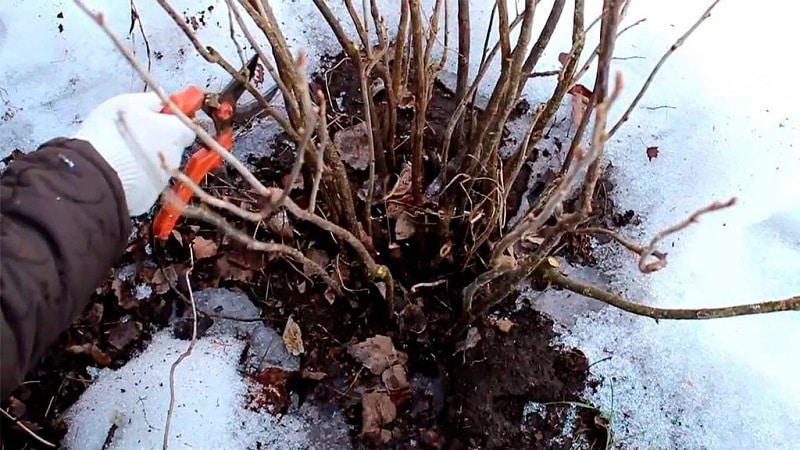
What does she need
Currants are quite unpretentious to soil quality and grow normally in shaded areas.. But without care, the bushes gradually degenerate, which significantly reduces the yield.
Spring care after winter includes the following activities::
- removing cover;
- watering;
- loosening;
- mulching;
- treatment against pests and diseases;
- feeding;
- pruning
Dates for spring procedures
Spring currant care usually begins immediately after the last snow melts.. The daytime air temperature should be around +5°C.
You can’t delay preparing currants for the upcoming season.. In the sun, the buds quickly swell and produce leaves. After this, it will be too late to take care of it.
Interesting things on the site:
Guide to planting currants in autumn
Necessary spring activities for a good harvest
To obtain a bountiful harvest, a number of procedures must be followed.. They strengthen the plant, prevent the development of diseases and speed up the growing season.
Removing cover
At the first stage, the winter shelter is removed. If you do not do this in time, the bush inside will begin to rot..
Remaining snow and litter are removed from the site if it was not removed in the fall. It is advisable to burn the leaves, as pests often remain in them.
The bush is carefully examined. If swollen buds are found, inside which a tick has overwintered, they are burned.
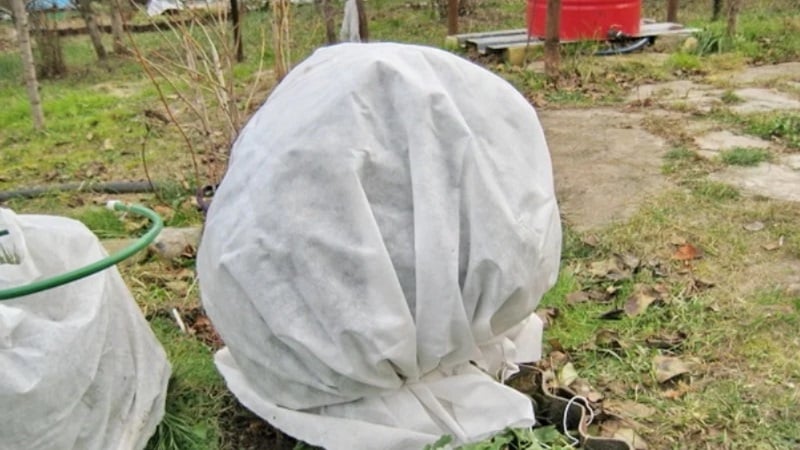
Trimming
Caring for currants in the spring after winter is also carried out with the help of proper pruning. In this way, the bushes are unloaded from damaged and diseased branches..
Shoots are also removed at the age of 4 years. Such branches practically do not produce fruit, but they take away nutrients from the plant, which could be used for the development of new shoots.
At the last stage of pruning, the crown is formed. On last year's elongated shoots, a maximum of 7 buds are left, the rest is cut off. Thanks to this procedure, the shoot begins to develop in width, giving additional yield on layering.
Loosening
With the help of loosening, air and moisture exchange in the soil is improved. Thanks to this, the root system does not lack oxygen, and water does not stagnate on the surface for a long time. In spring, this procedure is very important.
Loosen the soil after watering. The maximum loosening depth is 5 cm. Otherwise, there is a possibility of damaging the weakened root system.
Watering
It is recommended to water currants with warm water.. In dry weather, watering is carried out once every 8-10 days.Each bush requires 4-6 buckets. Water is poured only at the root; branches and leaves should remain dry.
Top dressing
For abundant fruiting, currant bushes must be fed. The plant requires potassium and phosphorus. For full development, nitrogen supplements are added, but only together with potassium and phosphorus. Otherwise, the amino acid content in the juice will increase, and the plant will become attractive to pests.
It is forbidden to add chlorine-containing fertilizers during the growing season. - currants cannot tolerate them. It is best to use the ash of deciduous trees as a top dressing. It contains all the necessary elements. Take ⅓ of a bucket for one bush.
Also nitrophoska solution is often used. Use in strict accordance with the instructions. Fertilizing is applied every year during bud formation.
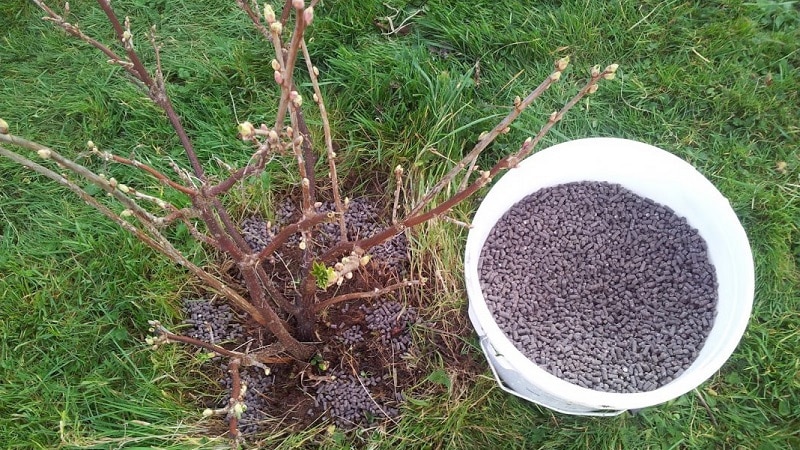
Mulching
Mulching is an important step in caring for currants. This the procedure will reduce the evaporation of moisture from the soil and the number of weeds. In addition, the amount of watering will be reduced.
For mulching use sawdust, straw or compost. Also, some gardeners use black non-woven material.
Treatment against diseases and pests
fight with insect pests begin in early spring using hot watering or fire treatment. The bushes are doused with boiling water even before the snow has completely melted.. The plant itself is not damaged, but mites and other pests die.
However, some gardeners do not approve of this method. They use insecticide spraying for prevention. Treatment with drugs is carried out only at positive air temperatures. Spray 2-3 times with an interval of 2 weeks.
Treatment with fire and boiling water
The method of pouring boiling water over bushes is used in the following cases:
- Kidney mite infestation. This pest carries a disease called leaf blight. In winter, it hides in the kidneys.
- Infection with fungal diseases, aphids.
With the help of hot water, they not only destroy pests, but also warm up the soil, buds and bark, and this contributes to a faster start of the growing season.
Treatment is carried out in early spring, before buds open.. It is performed in the first half of March. By this time, the buds have not yet swollen, so boiling water will not harm them.
For hot water treatment You will need a watering can with a fine mesh nozzle and a thermometer. The water temperature should be +70…+80°C. Water is boiled and poured into a watering can. The temperature is measured directly near the bush. If the liquid is still too hot, wait until it cools down.
To improve efficiency solution in water add 3 g of copper sulfate, 0.1 g of potassium permanganate and 10 g of salt. Water the bushes so that boiling water wets the entire surface of the branches.
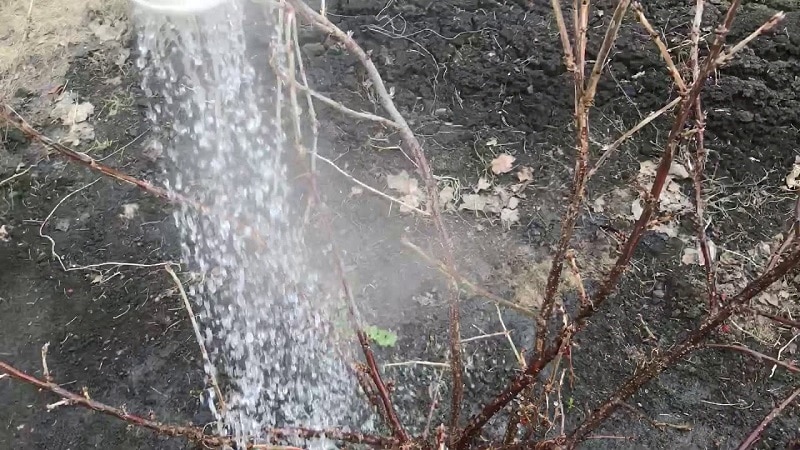
Many gardeners treat currants with fire. This method allows you to destroy aphids and mites. The procedure is carried out in early March. To do this, use a gas torch or blowtorch.
Keep the fire at a distance of 8-10 cm from the branches. They are carried along the shoots 2-3 times. Do not bring the burner too close to avoid damaging the branches.
Transfer
If the bush begins to bear fruit and develop poorly (new shoots do not appear even after pruning), then it is replanted.
Dig a hole about 40 cm deep. Add fertilizer or compost and pour out a bucket of water. After this, the bush is moved to a new place, covered with earth and watered again. The procedure is performed only if the plant buds have not yet swollen.
Read also:
Features of care depending on the region
Be sure to take into account the climatic features of the area where the crop is grown.
In different regions, spring procedures are carried out at different times:
- In the southern regions, care begins in early March, immediately after the soil dries out.
- In the middle zone, this time shifts to mid-April.
- In the Urals, Siberia and the North-West (Leningrad region), spring care begins at the end of April or beginning of March.
Spring planting of currants
In order for currants to bear fruit well, they select flat areas where there are no strong winds. Low-lying, shaded areas are not suitable for planting.
Also it is important to land on time. Otherwise, the plant may not take root.
When and how to plant
Planting seedlings in open ground is carried out before the onset of stable heat.. Deadlines vary by region. It is best to start work immediately after the last snow has melted. In the middle zone this is the beginning of April.
The roots should be wrapped in a damp cloth. Immediately before planting, seedlings are soaked in Kornevin solution.
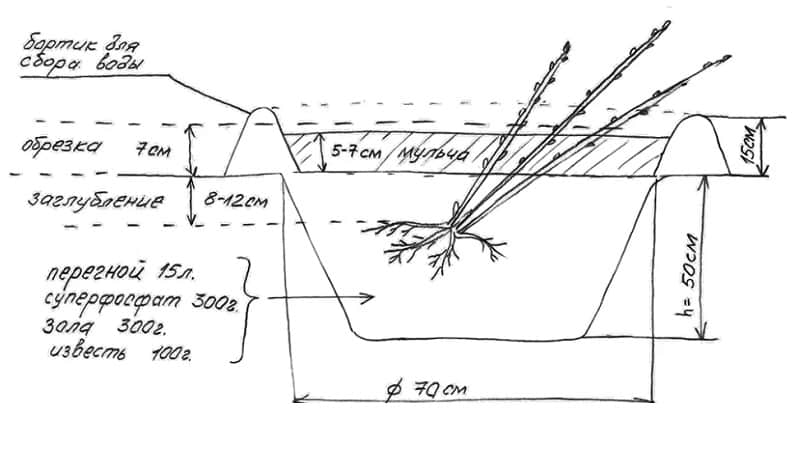
How to plant:
- First, holes are dug for the bushes. Their size should correspond to the size of the root system.
- Fill the hole ⅓ full with humus and add 1 tbsp. ash.
- Fill with 1 bucket of water.
- The seedlings are carefully inspected and dry and damaged roots are removed.
- The plant is placed in the hole at an angle of 45°. This way, the currants will better grow new shoots and develop the root system.
- Sprinkle the seedling with soil, making sides around the hole.
- All shoots are pruned. Only 4 buds are left on each.
- The plant is watered, after which the soil around the seedling is mulched with straw or sawdust.
Advice from experienced gardeners
The duration of fruiting and the yield of currants depends on proper care. There are certain secrets that are definitely important to know.
5 golden rules
Exists several rules that experienced gardeners adhere to:
- For all bushes that are more than 5 years old, anti-aging pruning is performed. Only disinfected instruments are used.
- If the cut thickness is more than 8 mm, it is treated with garden varnish.
- Winter shelters of bushes are removed as early as possible. After this, the soil is loosened to allow air to reach the roots.
- Be sure to treat plants against diseases and pests.
- After watering, the ground is mulched.
Mistakes to Avoid
Many Beginner gardeners make the same mistakes:
- Late maintenance work, for example pruning too late.
- Incorrect procedure. There is no point in treating pests first and then pruning.
- Lack or too much fertilizer.
- No anti-aging pruning. Every year the yield will decrease.
- Ignoring treatment for diseases and pests.
Conclusion
Spring care of black garden currants does not cause any particular difficulties. The main thing is to carry out events on time. Do not forget to treat the bushes from pests, prune and fertilize, as these procedures are equally important for fruiting.